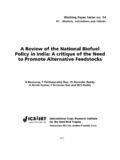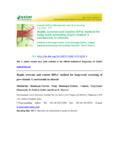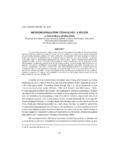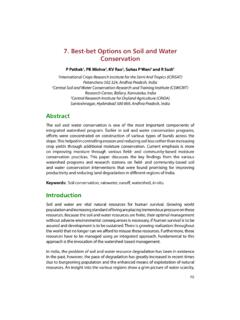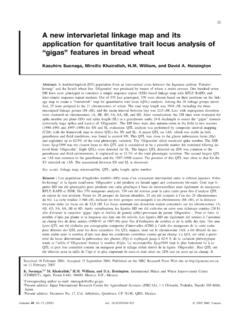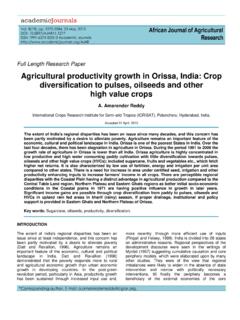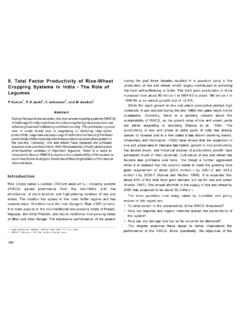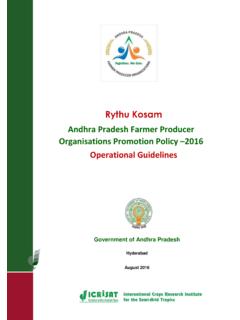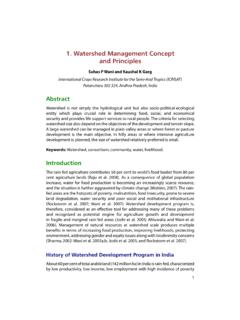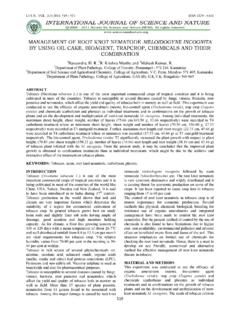Transcription of Major Diseases of Groundnut - ICRISAT
1 Human Resource Development Program ICRISAT International Crops Research Institute for the Semi-Arid Tropics Patancheru, Andhra Pradesh 502 324, India 1992 Skill Development Series no. 6 Faujdar Singh and Oswalt Compiled by M a j o r Diseases of Groundnut Major Diseases of Groundnut Compiled by Faujdar Singh and Oswalt 1992 Skill Development Series no. 6 ICRISAT Human Resource Development Program International Crops Research Institute for the Semi-Arid Tropics Patancheru, Andhra Pradesh 502 324, India Publications in this Skill Development Series (SDS) are issued semiformally for limited distribution to program participants, colleagues, and collaborators. Copies may be requested by the SDS number. Constructive criticism from readers is welcomed by: Program Leader, Human Resource Development Program, ICRISAT .
2 Information has been taken from published and unpublished reports. This publication should not be cited as a reference. Comments, suggestions, and encouragement from Drs Reddy, Smith, P. Subrahmanyam, Sharma, N. Rama Krishna, D. McDonald, and Nene for compiling this document are gratefully acknowledged. Thanks to Mr Prasad Rao for computerizing this manuscript. Human Resource Development Program Acknowledgments Contents Introduction 5 Fungi Bacteria Viruses Nematodes disease Assessment 5 6 6 6 7 Diseases of Groundnut 8 Fungal Diseases Bacterial disease Virus Diseases Nematode Diseases 8 8 8 8 MP 1. Seed Rots and Seedling Diseases of Groundnut MP 2. Groundnut Pod Rots MP 3. Groundnut Yellow Mold MP 4. Determination of Seed Resistance to Colonization by Aspergillus flavus 9 10 10 11 MP 5.
3 Groundnut Rust MP 6. Rust Screening in the Field MP 7. Rust Inoculation in the Laboratory MP 8. Early and Late Leaf Spots of Groundnut 12 13 15 16 MP 9. Screening for Early and Late Leaf Spots MP 10. Use of Cob's Diagram for Percentage Leaf Area Damage by Rust and Early and Late Leaf Spots MP 11. Bud Necrosis MP 12. Groundnut Rosette 17 21 22 23 MP 13. Peanut Clump MP 14. Detection and Inoculation of Plant Viruses MP 15. Bacterial Wilt of Groundnut MP 16. Methods to Identify Plant Parasitic Nematodes 24 24 29 30 MP 17. Root-Knot Nematode MP 18. Root Lesion Nematode MP 19. Ring Nematode MP 20. Testa Nematode 32 33 34 34 MP 21. Sting Nematode 35 References 36 Annexure I 38 Annexure II 39 Evaluation 40 Introduction Myxomycota. This group includes unicellular fungi that produce Plasmodium or pseudo Plasmodium.
4 These fungi are mostly propagated by motile zoospores formed in Plasmodium. Resting spores are also produced. Kumycota. This group consists of filamentous fungi. These are classified into five subdivisions based on sexual spores. Mastigomycotina. They produce asexual spores in sporangia. They include downy mildews and many pathogenic species of the water mold genera. Their mycelium is mostly nonseptate, and the spores liberated from the sporangia may be motile in some cases. Many species cause seed decay and seedling failure of plants that are grown in wet soils. The examples are Pythium and Phytophthora. Zygomycotina. These include Rhizopus spp. and Mucor spp. The sexual spores are zygospores. Asconycotina. These fungi destroy foliage and parts of plants that are above ground by abundantly producing ascospores on infected foliage that spreads by wind and water.
5 Filamentous ascomycotina produce several spores that spread with splashing rain or by air. It includes powdery mildew and sexual stages of fungi such as Aspergillus flavus, Cerospora arachidicola, and Cercosporidium personatum. Basidioaycotina. These include rusts and smuts that are host specific pathogens, and often have a complex life cycle. Deuteromycotina, or Fungi imperfecti. In these fungi the sexual reproductive stage is unknown or seldom found. This group includes leaf-spotting fungi such as species of Alternaria, Cercospora, Phoma, and Colletotrichum. The perfect stage, , teleomorph, if found, are usually in ascomycotina, although some are in Basidiomycotina. HRDP SDS no. 6 5 Fungi Fungi are nonchlorophyllous, nucleated, unicellular, or multicellular filamentous bodies that are reproduced by sexual or asexual spores.
6 Plant pathogenic fungi survive in soil, seed, and weeds. These are dispersed by insects, wind, water, and animals. Fungi live as either saprophytes on dead tissue or as parasites on living tissue. Some fungi are biotrophs, , active only in the living host. The fungal pathogens are classified into two Major divisions, Myxomycota and Eumycota (Ainsworth et al. 1973). disease is an alteration in one or more normal physiological processes, resulting in a loss in utilization of energy in plants. The concept of disease embraces any loss of a plant's ability to function normally or to coordinate the production and utilization of energy. Organisms causing Diseases are fungi, bacteria, viruses, and nematodes. Nematodes Nematodes (Greek for thread) are elongate, tubular organisms that move like a snake.
7 These are nonsegmented round worms, sometimes referred to as eelworms or simply nemas. Their body is long, narrow, and the internal organs consists of a set of tubes enclosed by the body wall. The alimentary canal runs directly back from the anterior mouth chamber (stoma) to the posterior anus. The excretory system is a long coiled tube or set of tubes that discharge to the exterior through a duct in the body wall in the anterior third of the body. There are no blood vessels. The nervous system consists of a limited number of nerve cells clustered in a group anteriorly and another posteriorly. Nerve fibers extend along 6 SDS no. 6 HRDP An agent that transmits a virus is called a vector. In many plants, viruses are transmitted under natural condition by insects.
8 Some of them are also transmitted by mechanical sap inoculation. Viruses are also transmitted by seed, especially in the plants of Leguminosae. o They are composed of protein and nucleic acid. o They contain one type of nucleic acid, either RNA, or DNA. o They multiply only in the host cell (obligate pathogens). o The RNA and protein subunits are formed separately in the host cell and combine to form intact virus particles. o Viruses do not possess enzyme systems, required to perform metabolic processes. o They are transmitted by graft inoculations, by sap, by insects, and by nematodes. Viruses The word 'virus' means poison or the poisonous element by which infection is communicated. The virus can be defined as a transmissible parasite whose nucleic acid genome is less than 3 x 108 daltons in mass and that need ribosomes and other components of their host cells for multiplication (Gibbs and Harrison 1976).
9 Plant viruses are submicroscopic entities showing obligate relationship with living cells of the host and ability to cause specific Diseases . The majority of the plant viruses possess the following characteristics (Feakin 19 73). Bacteria Bacteria are unicellular, primitive, plant-like, procaryotic organisms, and lack an organized nucleus. Plant pathogenic bacteria are mostly rod shaped, nonmotile, or motile by means of one or more flagella on their body. Plant pathogenic bacteria are usually gram-negative. The bacteria are mainly dispersed through seed, soil, air, and water. Sometimes insects also transmit bacterial cells. Bacterial infection in plant causes specific Diseases such as blight, soft rot, leaf spots, tumors, cankers, and vascular wilt. the body wall. Most, nematodes are circular in cross section.
10 The dorsal (back) region differs from the ventral. The right and left lateral sectors are distinct from either the dorsal or ventral sector (Fig. 1 ) . The sexes are separate in most nematode species. Females are larger than males. The female gonad consists of one or two elongated tubes. The gonad wall is a single layer of flat cells forming a tube with many distinct regions. The ovary is at the distal end. The region of cell division (germinal zone) contains small cells, called oocytes. These enlarge and in the growth zone accumulate the cellular machinery for embryo formation. The gonad lining changes and the gonad narrows in the next section (oviduct). This connects the ovary to the uterus, a region of enlarged diameter. A pouch-like structure, the spermatheca is situated between the oviduct and uterus.
